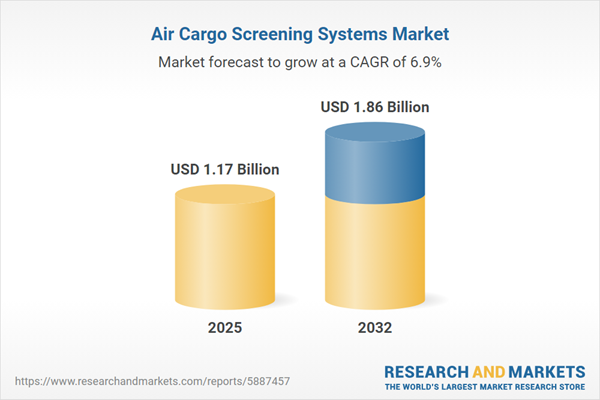Speak directly to the analyst to clarify any post sales queries you may have.
Air cargo screening systems are entering a pivotal era, as global supply chains demand greater resilience and security. Senior stakeholders face more complex risks and evolving compliance requirements, making advanced screening solutions crucial for uninterrupted and secure operations.
Market Snapshot: Air Cargo Screening Systems Market Growth Overview
The Air Cargo Screening Systems Market grew from USD 1.09 billion in 2024 to USD 1.17 billion in 2025. It is expected to continue growing at a CAGR of 6.87%, reaching USD 1.86 billion by 2032. This expansion reflects rising cargo volumes, new regulatory mandates, and a strong focus on threat mitigation across international routes.
Scope & Segmentation: Comprehensive Coverage across Segments and Regions
- Deployment Models: Fixed and mobile screening units address both permanent site needs and flexible, rapid deployment scenarios.
- Applications: Solutions for bulk cargo and mail screening ensure compliance with varied governmental and market standards.
- Component Types: Hardware, software, and service modules enable integrated performance monitoring and seamless upgrades.
- End Users: Airlines, logistics providers, airports, and government/security agencies each require tailored solutions for in-house and outsourced screening.
- Technology Options: Computed tomography (CT), metal detectors, millimeter wave imaging, x-ray platforms, trace detection systems (ion mobility and mass spectrometry) offer diverse inspection capabilities.
- Regional Coverage: Includes North America (United States, Canada, Mexico), Latin America (Brazil, Argentina, Chile, Colombia, Peru), Europe (United Kingdom, Germany, France, Russia, Italy, Spain, Netherlands, Sweden, Poland, Switzerland), Middle East (UAE, Saudi Arabia, Qatar, Turkey, Israel), Africa (South Africa, Nigeria, Egypt, Kenya), and Asia-Pacific (China, India, Japan, Australia, South Korea, Indonesia, Thailand, Malaysia, Singapore, Taiwan).
- Leading Companies: Smiths Detection Ltd., OSI Systems, Inc., L3Harris Technologies, Inc., Leidos Holdings, Analogic Corporation, Nuctech, Astrophysics Inc., Autoclear LLC, Morpho Detection, VOTI Detection Inc.
Key Takeaways: Strategic Insights for Senior Leaders
- Advanced imaging and analytics are redefining threat detection precision, improving both workflow efficiency and regulatory compliance.
- Integration of cloud-based systems and IoT sensors facilitates predictive maintenance, remote diagnostics, and effective allocation of resources.
- Modular and scalable equipment options help organizations adapt quickly to shifting operational and budgetary needs.
- Collaborations among airlines, airports, and regulatory bodies enable greater interoperability and accelerate the adoption of new best practices.
- Operational success increasingly depends on proactive risk management, continuous talent development, and scenario planning to address emerging threats.
- Market competition is driven by research and development focused on AI-enabled recognition, end-to-end service enhancements, and collaborative product innovation.
Tariff Impact: Navigating New Economic Realities
The introduction of additional trade duties in 2025 is prompting screening system manufacturers to optimize sourcing and production strategies. Many end-users are reassessing investment approaches, favoring modular deployments and innovative financing to maintain access to advanced solutions while managing costs. Collaborative procurement models among stakeholders are also helping mitigate financial pressures and speed up installation across networks.
Methodology & Data Sources: Reliable Research for Strategic Clarity
This analysis leverages a mixed-methods approach, combining secondary research from regulatory publications, industry reports, and product data with primary interviews of industry executives, procurement officials, and solution vendors. Comprehensive data triangulation and expert validation underpin findings, ensuring actionable and trustworthy insights for decision-makers.
Why This Report Matters: Actionable Benefits for Executives
- Enables informed, long-term planning by mapping key regulatory and technological developments in air cargo security.
- Highlights competitive dynamics and partnership opportunities to optimize procurement and operational decision-making.
- Provides a deep dive into regional trends and technology options for targeted investment strategies that support sustained resilience.
Conclusion
The Air Cargo Screening Systems Market is rapidly evolving to meet the demands of a changing global risk landscape. Organizations that prioritize innovation, flexible procurement, and collaborative security strategies will enhance operational continuity and long-term competitiveness.
Additional Product Information:
- Purchase of this report includes 1 year online access with quarterly updates.
- This report can be updated on request. Please contact our Customer Experience team using the Ask a Question widget on our website.
Table of Contents
3. Executive Summary
4. Market Overview
7. Cumulative Impact of Artificial Intelligence 2025
Companies Mentioned
The companies profiled in this Air Cargo Screening Systems market report include:- Smiths Detection Ltd.
- OSI Systems, Inc.
- L3Harris Technologies, Inc.
- Leidos Holdings, Inc.
- Analogic Corporation
- Nuctech Company Limited
- Astrophysics Inc.
- Autoclear LLC
- Morpho Detection SAS
- VOTI Detection Inc.
Table Information
| Report Attribute | Details |
|---|---|
| No. of Pages | 189 |
| Published | October 2025 |
| Forecast Period | 2025 - 2032 |
| Estimated Market Value ( USD | $ 1.17 Billion |
| Forecasted Market Value ( USD | $ 1.86 Billion |
| Compound Annual Growth Rate | 6.8% |
| Regions Covered | Global |
| No. of Companies Mentioned | 11 |









